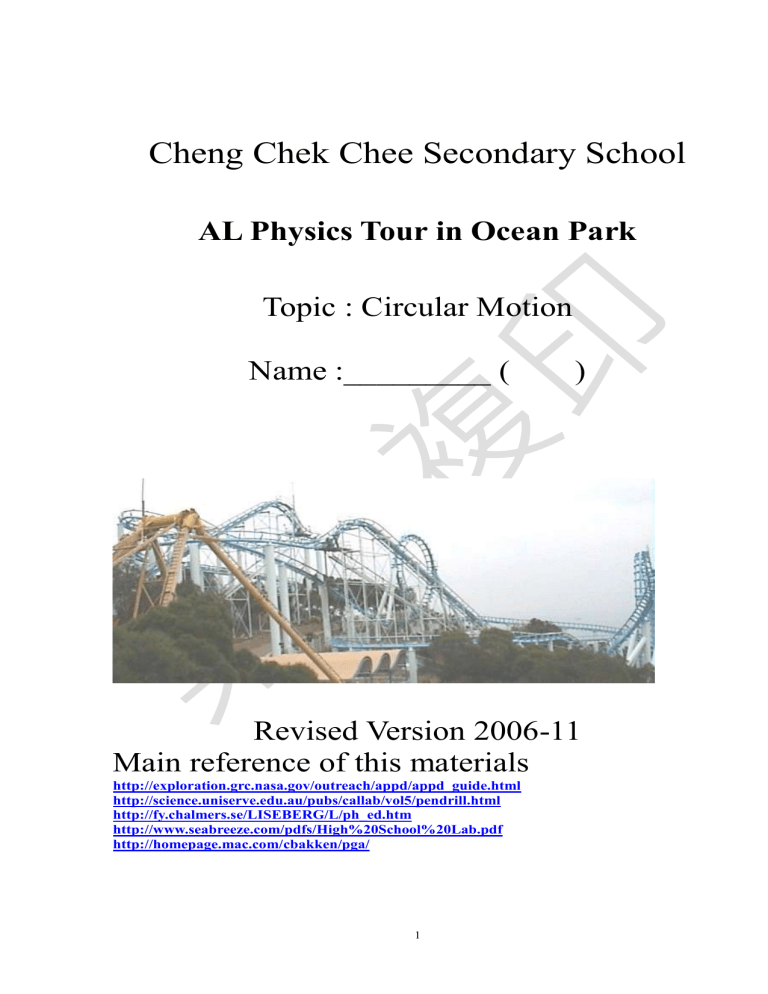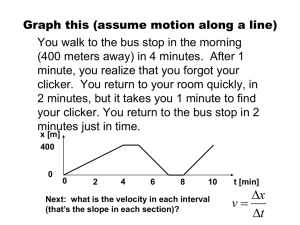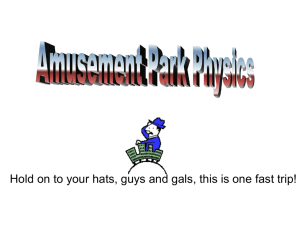AL Physics Tours in Ocean Park
advertisement

Cheng Chek Chee Secondary School AL Physics Tour in Ocean Park Topic : Circular Motion Name :_________ ( ) Revised Version 2006-11 Main reference of this materials http://exploration.grc.nasa.gov/outreach/appd/appd_guide.html http://science.uniserve.edu.au/pubs/callab/vol5/pendrill.html http://fy.chalmers.se/LISEBERG/L/ph_ed.htm http://www.seabreeze.com/pdfs/High%20School%20Lab.pdf http://homepage.mac.com/cbakken/pga/ 1 Safety Precautions 1. All three groups should work together under the supervision of the Teacher Assistant. 2. Shoes or sneakers are a must. Sandals, loose footwear, loose jackets, and long hair are dangerous on some rides. Remind your students that they must observe any posted regulations. 3. Evaluate your measuring devices for safety before you leave school. Avoid anything with sharp ends. Devices must be lightweight and capable of being tethered to the wrist to avoid loss during a ride. 4. Students have to check that seat belts and harnesses are secured. The rides are designed to be safe. Students should double-check for themselves. 5. The sun can be a problem. Sun block and sun visors are a must on what may be their first full day in the sun this year. 6. Remember — No one is forced to ride. Measurements can be taken from the ground and accelerometer readings can be shared. 時間 8:30 9:45-10:15 10:1510:45-2:00 2:00 –2:30 2:30-3:30 3:45-4:45 5:00 11 月 10 日行程 地點 金鐘地鐵站 大樹灣入口 岩石課室 山上機動城 登山纜車 兒童王國 常綠長青實習工作間 正門 活動 集合 票務/前往岩石課室 行程簡介及儀器借用 動感體驗 前往兒童王國 動感體驗 匯報/實驗 解散 mobile telephone : __________________ The group and Apparatus List Team A Instructor Kit Op Computer Group 1 Apparatus Leader: Explorer Op 1 2 Camera 3 4 Group 2 Apparatus Leader: Explorer OP 1 2 Camera 3 4 Route 1.Flying swing 2.Dragon 3.Crazy Galleon 4.Absyy 5.Mine train Team B Instructor Group 3 Leader: 1 2 3, 4 Group 4 Leader: 1 2 3 4 Route 1..Dragon 2.CrazyGalleon 3.Absyy 4.Flying swing 5.Mine train Wai Han Physics (lab) Apparatus Explorer Camera Apparatus Explorer Camera 2 Team C Instructor Group 5 Leader: 1 2 3 4 Group 6 Leader: 1 2 3 4 Route 1.Crazy Galleon 2.Absyy 3.Flying .swing 4.Dragon 5. Minetrain Physics (gp 2) Apparatus Explorer Camera Apparatus explorer Camera 3 The weight and apparent weight In order for a person to feel weight, a person must sense the reaction force of the ground pushing in the opposite direction of gravity. In the absence of the reaction force a person will sink through the ground. To calculate the g's felt remember that the g's felt by the rider is the normal force on the seat of the rider divided by the mass then converted into g's. mg is the weight The centripetal force is R-mg R The apparent weight of the feeling of weight is Reaction R R – mg = mv2 /r => The acceleration R = mg + mv2 /r g’ is measured by the accelerometer = R/m mg R/m = g + mv2 /r => g’ = g + mv2 /r => g’ > g , a larger g. The sensor The sensor can measured the X, Y and Z ,the resultant accelerations and Also the Height of the Sensor. 4 Activity: Feeling the acceleration of The Crazy Galleon Key Learning Points: 1. Centripetal Acceleration 2. Newton's second law 3. Weight 4. Free-body diagram 5. Circular motion Introduction The Crazy Galleon is one of the pendulum rides. Although most pendulum rides do not make a full circle, riders do experience circular motion. After taking the ride, students will be asked to explain the motion of the ride based on their feeling and their knowledge of physics. The activity is designed to reinforce students' understanding of Newton's second law and its application to an accelerating ride. Background knowledge The Crazy Galleon is one of the pendulum rides. Although most pendulum rides do not make a full circle, riders do experience circular motion. Swinging back and forth on this curved path allows you to feel the sensations of high and low g (“g” refers to the force caused by the acceleration of gravity). A drawing of a typical pendulum-type ride. Procedure Students take the Crazy Galleon in different location of the boat for different groups take the data by the datalogger . Note the three stages of motion when the ride is thrust downwards. Describe your feeling and note your apparent body weight (a) almost instantly at rest , (b) at the lowest part , and (c) at the highest point Note your apparent body weight in the highest point as the amplitude of the swing increases. Interpret the motion of the ride based on your feeling at each stage. 5 Fill in the worksheet. Questions for discussion 1 Take the accelerometer on the ride. Label figure 1 where you experienced a. The highest g, lowest g, and 1 g b. Your weight to be normal, heavier, or lighter Fig1 2 Where are you traveling the fastest? Slowest? Fastest :_________________ , slowest :_____________ 3 Draw force diagrams and explain briefly the feeling of weight in the following cases. a. At rest. b. Moving through the lowest point. c. At the highest point. 4 How is your feeling of apparent weight changed, as the ride swings higher? 5 Does the number of people on the ride alter your results or conclusions? Please support your answer. Electronic Data Collection 7. Record your vertical accelerometer readings in the largest oscillation: Sitting on the middle Sitting at Both ends 1. At rest. _________________ 1. At rest. _________________ 2. Moving through the lowest point. _______ 2. Moving through the lowest point. ______ 3. At the highest point. _________________ 3. At the highest point. _______________ 6 8. Where should you sit to feel the lightest: near the center or far from the center of the ride? Please support your answer. 9. Determine the period of oscillation: a. for small oscillations. b. for large oscillations. Is the period affected by the amplitude of the oscillation? Does this approximate the behavior of a pendulum? Please support your answer. 10. Where did the maximum acceleration occur? Is this point the same for every seat? 7 Activity: Motion of the 'Dragon' Key Learning Points: 1. Centripetal Acceleration 2. Newton's second law 3. Weight 4. Free-body diagram 5. Circular motion Procedure Try to remember the sequence of rises and falls in this part of the track. Take the 'Dragon'. Experience the change in speed in the actual rises and falls. Write down what you have experienced in the worksheet. Experience the change in feeling of weight in the actual rises and falls. Write down what you have experienced in the worksheet. In different seats for different group. Student Worksheet -- dragon The Background knowledge The loops of a roller coaster are not circles; they are called Clothoid loops (or Klothoid loops). Roller coasters use Clothoid loops, which have a smaller radius at the top of the loop, and a longer radius where the cars enter and exit the loop (see fig. 1). Fig 1 The designers of the Clothoid loop have invented a shape that controls the forces you experience as you go around the loop. The unique shape of the loop decreases the forces exerted on you as you enter and leave the loop, but maintains the force necessary to keep you in your seat as you go over the top of the loop. Thus, the shape of the loop controls the forces you experience. At points A and E, where the coaster has the highest speed, the Clothoid loop is curved more gently (larger radius) than the circular loop. Consequently the reaction you experience is less in the Clothoid loop than in the circular loop. Explain briefly why the reaction you experience is less in the Clothoid loop than in the circular loop at the bottom part at point A or E ________________________________________________________________________ 8 ________________________________________________________________________ _____________________________________________________________________________________ _____________________________________________________________________________________ _____________________________________________________________________________________ _____________________________________________________________________________________ At point C, where the coaster is moving in the slowest speed, the Clothoid loop is more tightly curved than the circular loop. Thus as you cross the top of the Clothoid loop ; the reaction is larger than a circular loop, which keeping you from falling out. Explain briefly why the reaction you experienced is larger top at point C. in the Clothoid loop than in the circular loop at the _____________________________________________________________________________________ _____________________________________________________________________________________ _____________________________________________________________________________________ _____________________________________________________________________________________ BANKED CURVES of the loop. A banked curve reduces the rider's sensation of being thrown sideways by turning the car sideways. The car is tilted. The trick is to tilt the track just the right amount. The ideal banked curve is one where no outside forces are needed to keep the car on the track. In other words, if the banked curve were covered with ice -no friction- and the coaster did not have a steering mechanism the car would stay on the track. Questions Use your vertical accelerometer to obtain vertical acceleration readings at each of the five places identified above for the vertical loop on one of the rides. At the same time, use the horizontal accelerometer to measure the longitudinal acceleration in the same places. Record your values in the data table, and answer the questions that follow. C D B E 9 Q1 Vertical Acceleration Longitudinal Acceleration Relative Speed * Your feeling of your weight* A B C D E * Use these descriptors: smallest, small, medium, large, largest -- with -- increasing, decreasing, steady, feel heavier, lighter, or normal in your seat Q2 Draw the free body diagram to show all the forces acting on the Correct rider (only one cart) in the following diagrams and explain briefly why you feel heavier , lighter or normal in the above cases heavier Lighter Explanation by Newton's law Explanation by Newton's law As the speed is very fast such that V2 /r > g Then R As the speed is very fast such that V2 /r > g Then R 10 The Curve of the loop. (Picture Captured from the Film of the Ocean park “dragon” Q3. Explain briefly by the drawing forces acting on the cart on an ideal bank loop and show that the banking angle depends on the speed of the car and also the radius of curvature of the loop. Answer Extension http://www.pen.k12.va.us/Pav/Science/Physics/book/home.html 11 Activity: Motion of the Mine Train Key Learning Points: 5. Centripetal Acceleration 6. Newton's second law 7. Weight 8. Free-body diagram 5. Circular motion Procedure Try to remember the sequence of rises and falls in this part of the track. Take the 'Mine train'. Experience the change in speed in the actual rises and falls. Write down what you have experienced in the worksheet. Experience the change in feeling of weight in the actual rises and falls. Write down what you have experienced in the worksheet. In different seats for different group. Questions: 1. Find the section that the train is circulated around the steel frame in the above graph. In the circular motion part , Explain briefly why the acceleration Resultant acceleration (violet) is increasing as the height is decreasing. _____________________________________________________________________________________ _____________________________________________________________________________________ _____________________________________________________________________________________ _____________________________________________________________________________________ 12 Activity: Motion of the flying swing Key Learning Points: 1. Circular motion Introduction You will take a ride on the flying swing. You will experience the change in speed when the swing rises and falls, and feel the centripetal force acting on you . Background knowledge Drawing Force diagram Find out the centripetal force acting on the student. Procedure Observe the angle between and empty swing and a loaded swing before the the swing started and during the motion . Take the Flying swing'. Take the reading of accelerometer as the swing started Experience the change in speed and feeling of weight in the actual rises and falls. Write down what you have experienced in the worksheet. QUESTIONS: 1. When the ride is at rest, what is the angle between the swing and the vertical ? 2. When the speed of rotation increases, what is the change of the angle between the swing and vertical ? 13 3. Is there any different in vertical angles between a loaded swing and a empty swing. Explain briefly? 4. Where is the vertical acceleration experienced by the riders the greatest once the ride reaches its highest position? Where is it the least? 5. What is the difference between the two vertical acceleration readings in point 4 ? Applying physics principles to explain why you get this difference. 14 Activity: Feeling the acceleration of Abyss Turbo Drop (Department of Physics, The Chinese University of Hong Kong Copyright © 2003 Education and Manpower Bureau, HKSAR Supported by Ocean Park Hong Kong) Key Learning Points: 1. Acceleration 2. Newton's second law 3. Weight 4. Free-body diagram Introduction The Abyss Turbo Drop is thrust downwards at a high speed, giving the passengers a thrilling experience of rapid descent. After taking the ride, students will be asked to explain the motion of the ride based on their feeling and their knowledge of physics. The activity is designed to reinforce students' understanding of Newton's second law and its application to an accelerating ride. Background knowledge Basics Remind the students of the apparent change in weight inside a lift. In particular, a person would appear to lose weight when the lift is accelerating downwards. Let the students imagine what would happen if the cable of the lift breaks. Both the lift and person would fall with a downward acceleration of g, and the person would experience a weightless condition. Advanced Application of Newton's second law to the accelerating lift. Draw free-body diagrams to explain how the net force produces the observed acceleration. How do you feel when taking the Abyss Turbo Drop? Procedure Basics Take the Abyss Turbo Drop. Note the three stages of motion when the ride is thrust downwards. Describe your feeling and note your body weight (a) almost instantly after take off, (b) a second after take off, and (c) shortly before reaching the bottom of the tower. Interpret the motion of the ride based on your feeling at each stage. Fill in the worksheet. Advanced Draw a free-body diagram which indicates the forces acting on your for each of the three stages. Compare the diagrams with that of a lift accelerating downwards. 15 Student worksheet Feeling the first downward thrust Stage of Motion Feeling being pulled downwards / weightless / normal / gain weight / lose weight Interpretation of Motion accelerating / decelerating / moving at a constant velocity acceleration greater than / equals / less than g Instantly after take off A second after take off Shortly before reaching the bottom of the tower Discussion Basics The ride description of the Ocean Park says that the Abyss Turbo Drop will give you "a feeling of negative g, much faster than a free fall". Which stage of the motion does this description apply? What is meant by "negative g"? How do you feel at this stage? Have you experienced weightlessness in any stage of the ride? acceleration in this case? How do you feel shortly before reaching the bottom of the tower? (of course milder) when taking a lift? 16 What should be your Do you have similar feeling Advanced In each of the three stages, Stage of Motion Free-body diagram State the what is the net compare the magnitude indicate all the forces direction of the force acting on of your true weight mg acting on you in a force N exerted you? and the force N exerted free-body diagram. on you by the on you by the ride. ride Instantly after take off A second after take off Shortly before reaching the bottom of the tower 17 Activity: Merry-go-round(carousel) Ground Measurements Determine the angular speed of the merry-go-round. 1. Stand on the ground in front of the merry-go-round and locate a particular spot on the ride. Make sure that you have a way to remember that spot. Position yourself directly in front of it. 2. When the point that you have selected is directly in front of you, start your stopwatch and keep it running for ____ revolutions. Total time for _____ revolutions in seconds:_______________ 4. Calculate the angular speed : _____________________________ Merry-go-rounds Ride Measurements 1. There is a “lean” of the benches and on the poles that support the horses. When the ride is stationary, use your altitude tracker to determine the angle that an horse in the outer row makes with the vertical. While holding the tracker vertically, place it against the horse’s support pole, reading the angle between the washer and the zero mark on the tracker. Angle =_______________________________ 2. Measure the angle that an horse in the inner row makes with the vertical. Angle =__________ 3. Which horse has a larger angle, the one located in the inner row or the one in the outer row? 4. Do the same measurements on the very same horses while the ride is in motion. Inner angle:___________ Outer angle:_______________ 5. A student is sitting on a Cart in the outer sided and fixed on the Floor. Draw the position of the string of the pendulum as the merry-go-round Cart The String at rest The string in motion centre centre Angle = Angle = 6. How do the results of angle measurements compare when looking at stationary ride horses versus moving ride horses? Explain your answer by using the result find in point 5 . __________________________________________________________________________ __________________________________________________________________________ __________________________________________________________________________ 7. What is the advantage of sitting on a tilted Horse in stead of a vertical one. __________________________________________________________________________ __________________________________________________________________________ 18 Activity : Design a roller coaster Key Learning Points: 1. 2. 3. Conservation of energy. Newton law Circular motion Introduction By placing the Roller Coaster in a loop configuration, students can study the forces and motion involved in circular motion. The included cups can be filled with water and placed in the car. Students will marvel as no water is spilled as the car moves through the loop! Activities: you are request to design and construct a roller coaster by the following Kit d 2 h2 r Fig A Use the figure B below to sketch your design of a coaster roller runway. Fig.B Your runway should include a start, a vertical circular loop, a hill and and a stop. Please use your concept to have the following consideration. For maximum Height of the start is 0.6m , the diameter d of first vertical loop must be smaller than ____________ m For height of the second hill, h2, should __________ and the radius of curvature r of the curve of the top of the hill should be ___________. Otherwise , cart may leave the runway. Experiment: Some groups may have a chance to build the roller coaster runway in the activity room. 19





